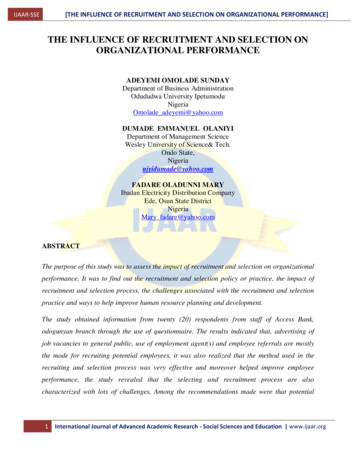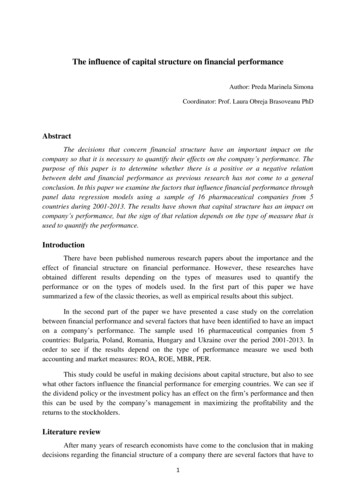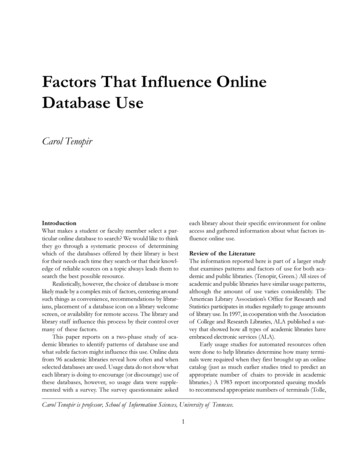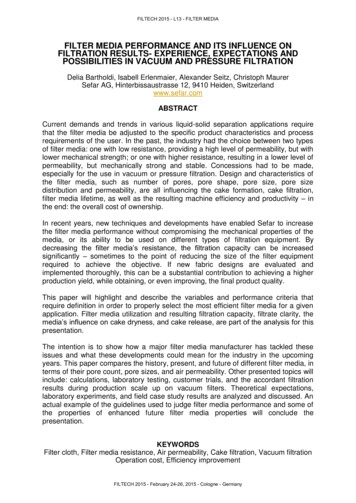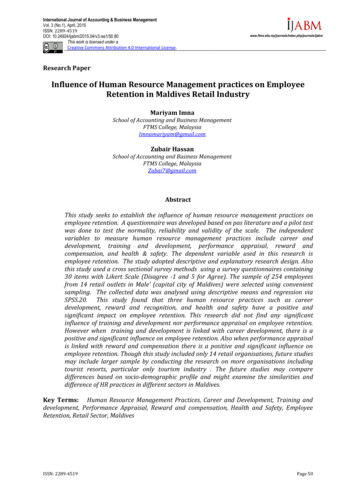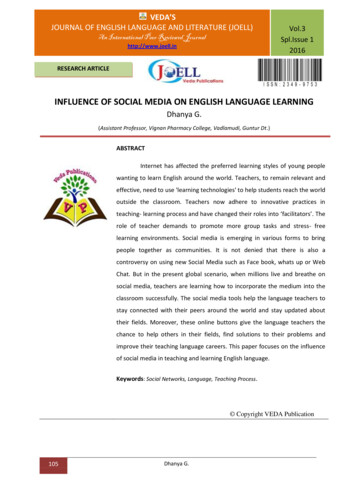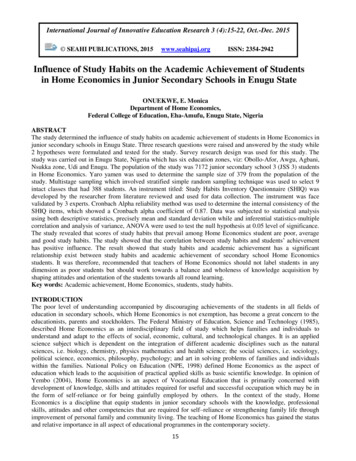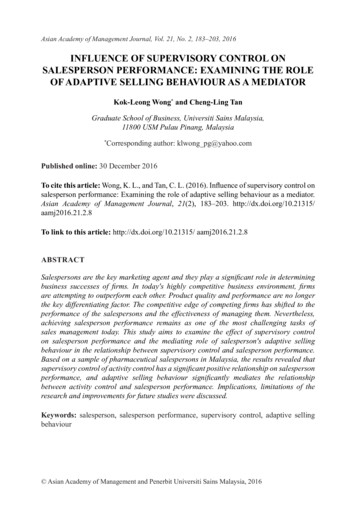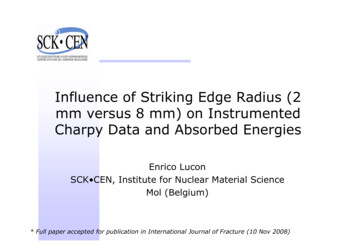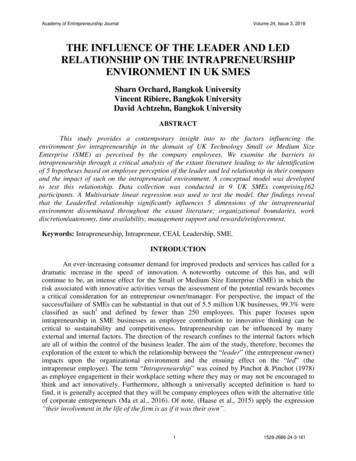
Transcription
Academy of Entrepreneurship JournalVolume 24, Issue 3, 2018THE INFLUENCE OF THE LEADER AND LEDRELATIONSHIP ON THE INTRAPRENEURSHIPENVIRONMENT IN UK SMESSharn Orchard, Bangkok UniversityVincent Ribiere, Bangkok UniversityDavid Achtzehn, Bangkok UniversityABSTRACTThis study provides a contemporary insight into to the factors influencing theenvironment for intrapreneurship in the domain of UK Technology Small or Medium SizeEnterprise (SME) as perceived by the company employees. We examine the barriers tointrapreneurship through a critical analysis of the extant literature leading to the identificationof 5 hypotheses based on employee perception of the leader and led relationship in their companyand the impact of such on the intrapreneurial environment. A conceptual model was developedto test this relationship. Data collection was conducted in 9 UK SMEs comprising162participants. A Multivariate linear regression was used to test the model. Our findings revealthat the Leader/led relationship significantly influences 5 dimensions of the intrapreneurialenvironment disseminated throughout the extant literature; organizational boundaries, workdiscretion/autonomy, time availability, management support and rewards/reinforcement.Keywords: Intrapreneurship, Intrapreneur, CEAI, Leadership, SME.INTRODUCTIONAn ever-increasing consumer demand for improved products and services has called for adramatic increase in the speed of innovation. A noteworthy outcome of this has, and willcontinue to be, an intense effect for the Small or Medium Size Enterprise (SME) in which therisk associated with innovative activities versus the assessment of the potential rewards becomesa critical consideration for an entrepreneur owner/manager. For perspective, the impact of thesuccess/failure of SMEs can be substantial in that out of 5.5 million UK businesses, 99.3% wereclassified as such1 and defined by fewer than 250 employees. This paper focuses uponintrapreneurship in SME businesses as employee contribution to innovative thinking can becritical to sustainability and competitiveness. Intrapreneurship can be influenced by manyexternal and internal factors. The direction of the research confines to the internal factors whichare all of within the control of the business leader. The aim of the study, therefore, becomes theexploration of the extent to which the relationship between the “leader” (the entrepreneur owner)impacts upon the organizational environment and the ensuing effect on the “led” (theintrapreneur employee). The term “Intrapreneurship” was coined by Pinchot & Pinchot (1978)as employee engagement in their workplace setting where they may or may not be encouraged tothink and act innovatively. Furthermore, although a universally accepted definition is hard tofind, it is generally accepted that they will be company employees often with the alternative titleof corporate entrepreneurs (Ma et al., 2016). Of note, (Haase et al., 2015) apply the expression“their involvement in the life of the firm is as if it was their own”.11528-2686-24-3-161
Academy of Entrepreneurship JournalVolume 24, Issue 3, 2018Intrapreneurs play a significant role as an integral part of the human capital within anycompany and there are two fundamental knowledge-intensive considerations that the extantliterature proposes underpin the likelihood of intrapreneurship within an organization; humancapital in terms of harnessing individual’s knowledge, skills, abilities and ideas, andorganizational support (Saks, 2006), in terms of providing the appropriate setting, conditions,resources and motivation, and, the potential output of a synergy between them. Rivera (2017)suggests that it is the business leader with a sustained commitment for transferring knowledgeinto organizational growth who will be skilled in the intrapreneurial concept. Within the SMEenvironment we observed the leader referred to as Founder, Owner, Chairman, ManagingDirector or Director. For consistency and to avoid confusion, we have adopted an all-embracingtitle which we define in this research paper as the “Leader”.LITERATURE REVIEWSME LeadershipIn contrast to large organizations, the personal characteristics of the SME Leadergenerally considered a highly influential factor in the workplace (Irwin & Scott, 2010, Barringeret al., 2005). As such, this study confines entrepreneurial leadership in businesses led andmanaged by the founder/owner who is actively involved in the business on a day-to-day basisdriving the conception, growth, current and future strategy.We may posit that in the early years of trading, the SME business leader persona and theidentity of the business may be indistinguishable. We propose the entrepreneurial leadershipapproach can materially influence employees to champion or ignore innovation. Kassa & Raju(2015) concur in that advocating or sponsoring new ideas positively influences intrapreneurialengagement. Furthermore, we should consider the findings of Scozzi et al. (2005) whichconcluded entrepreneurs felt that most innovative initiatives or original ideas came primarilyfrom them, not the workforce or third party collaborations. Todd (2010) proposes that companyowners often struggle with accepting new ideas that may threaten the foundations of the businessmodels they invented. As Karol (2015) suggests, the challenge for the entrepreneurial leader arethreefold; creating and aligning a vision which is non-threatening, establishing trust, and throughsustained commitment, gaining employee buy-in.Bagheri (2017) posits that it is essential that the SME leader adopts a stance ofencouraging their employees to challenge, explore, generate and implement new ideas, a positionshared by Fontana & Musa (2017); Leitch & Volery (2017) in respect of opportunity recognitionthrough a structured process espoused by the business leader. Meng & Roberts (1996) proposemany entrepreneurially-minded individuals leave large firms where new technologies werecreated, to set up SMEs to exploit the new technology they felt constrained from pursuing. Ateset al. (2013) cite a “command & control” culture between the leader and the led as indicativebehavior, specifically in SMEs whilst Aygun et al. (2010) and Brown et al. (2010) confer thatunless the control-oriented approach of the business leader is renounced it is extremely unlikelythat any form of intrapreneurship can thrive indicating “collaborative effort between the businessentrepreneur and these intrapreneurs is potentially beset with problems, issues and conflicts”.As expressed by Heinonen & Toivonen (2008), the relationship between entrepreneur andintrapreneur, if symbiotic, generates an environment in which employees are empowered.Without empowerment the confident intrapreneur may appear to be little more than a problem inthe entrepreneur business.21528-2686-24-3-161
Academy of Entrepreneurship JournalVolume 24, Issue 3, 2018Contextually, we should bear in mind that it could be that the entrepreneur is focused on“enterprise fulfillment” whilst the intrapreneur could be focused on “personal fulfillment”(Carrier 1997). Rogers (1995) posits that since opinion leaders directly affect the outcome ofan innovation, a powerful way for change agents to affect the diffusion of an innovation is toaffect opinion leader attitudes. This is supported by the view that intrapreneurial employeesmust be prepared for conflict, politics, tenacity and impart considerable persuasiveness inorder to be convincing (Prasad 1993) and, that in order to be successful, intrapreneurs mustactively seek out a leader who is more likely to make innovation happen rather than block it(Pinchot & Pellman 1999).Intrapreneurship in SMEsThe least explored aspect of intrapreneurship appears to be its evaluation within SMEs(Covin & Slevin 1991). What has become acknowledge as the first significant study wasundertaken by Carrier (1997) whilst assessing the concept in Canada. Citing Carrier (1994) asthe main contributor in the field, Bouchard and Basso (2011: 224) deduced from her work that“SME leaders have a major impact on intrapreneurship, which they can readily encourage orinhibit depending on their assessment of the level of convergence of their employees’ initiativesand their personal attitude towards their employees”. In 2011, Bouchard & Basso proposed therehad been no further similar noteworthy research efforts, in 2013 Van der Sijde et al. reportedknowledge of intrapreneurship in small organizations remained limited, in 2017, Ling et alviewed the subject as neglected. Throughout our exhaustive efforts to corroborate theinformation presented we concur2.It is reported that in 2016, total employment in UK SMEs was 15.7 million whichaccounted for 60% of all private sector employment; that the number of SME businesses hadincreased by 97,000 over the previous year and by 2 million since 20003. Furthermore, that thecombined annual turnover of SMEs was 1.8 trillion (47 percent of all private sector turnover inthe UK)4 which emphasizes the importance of their competitiveness and sustainability both froman employee and economic perspective. Given the continued expansion of existing and newSME business ventures has proved a vital source of both revenue and employment, we find theability to innovate is often considered crucial to their continuation (Binnui & Cowling 2016,Poutziouris, 2003) and, that intrapreneurship could play a very effective and integral role to theirfurtherance, and potentially, survival (Rivera, 2017; Karol, 2015; Brown et al., 2010). Finally,Carrier (1994) adds that it is within the SME rather than large corporation environment thatintrapreneurs can be more easily identified.In summary, the above highlights why intrapreneurship is a valuable concept worthy offurther research study due to a necessary expansion and survival of the UK SME sector and thejuxtaposition of business births versus business deaths (Source: ONS Business Demography2016). Indeed, Rivera (2017) reports that the even the most resilient companies are not immuneto a “gradual erosion of their positions”. For employees, “lifetime employment” has become athing of the past; it may well be the intrapreneur that secures their future by repeatedly creatingand adding value within the business.Internal Organizational Factors Influencing IntrapreneurshipAn analysis of extant literature offered numerous internal organizational factorsinfluencing intrapreneurship in the workplace. For example, Amabile (1998) provided an31528-2686-24-3-161
Academy of Entrepreneurship JournalVolume 24, Issue 3, 2018exploration titled “KEYS” comprising 78 questions used to assess the potential for creativity inthe working environment. Six constructs emerged, Challenge, Freedom, Resources, SupervisoryEncouragement, Work-Group Features and Organizational Support. A further example of a wellcited research contribution can be found in the Corporate Entrepreneurship AssessmentInstrument (CEAI) originally created in 1990 by Kuratko et al. and reassessed by Hornsby et al.,2002. The authors offer 5 constructs, Organizational Boundaries, Work Discretion/Autonomy,Time availability, Management support and Rewards/Reinforcement. Of note these 5 constructswere positively evaluated in studies by Alpkan et al. (2010) exploring organizational support forintrapreneurship, by Rutherford & Holt (2007) assessing how individuals are encouraged toengage in entrepreneurial activities in an organization and by Mar ban et al. (2013) reviewing theeffective factors in organizational entrepreneurship climate. Additionally, Hayton (2005) submitsthat the categories identified and used within the instrument were subject to studies confirmingthe empirical significance of these five dimensions of organizational environments for promotingcorporate entrepreneurship.For a study titled Fostering Intrapreneurship, Dortmund University created ameasurement tool to assess a Measurement of Organizational Preparedness for CorporateEntrepreneurship. The survey evolved into more than 120 questions (including the CEAI in itsentirety) and was completed on-line by random participants through a media group site. Its scopewas sufficiently general in terms of work related factors and broad in terms of demographicfactors that it did not merit replication for assessing the defined design of our research objectives.Sayeed & Gazdar (2003) took a different approach with an intrapreneurship scale for assessingand defining the attributes of intrapreneurs to evaluate appropriate organizational factors. Itcomprised 7 conceptually defined dimensions in what could be considered a dissection ofindividual characteristics; adventurer, innovator, designer, leader, entrepreneur, change agent andanimateur. This was also deemed unsuitable for replication as it placed scant focus on therelationship between the leader and the led. We are reminded that it is the level of commitmentand understanding between these two parties which has a significant impact upon intrapreneurialbehavior (Farrukh et al., 2017).The Leader and the LedAs discussed, this dimension is pivotal to all aspects of organizational factors influencingintrapreneurship. An objective of this research paper is to discover how leaders not only view,but interact with their employees. Within the SME workplace this is likely to highly visible as incontrast to large organizations, the personal characteristics of the leader are generally consideredthe most influencing factor. For example, Bagheri (2017); Ates et al. (2013) and Irwin & Scott(2010) indicate a direct association between innovative activities in SMEs and the personality ofthe business leader and his/her ethos and principles. Key to our understanding is an examinationof the business leader’s attitude and behaviors, their degree of involvement with individuals andteams as perceived by the employees, the understanding and synergy between the two parties interms of communication, respect, approachability, su
In summary, the above highlights why intrapreneurship is a valuable concept worthy of further research study due to a necessary expansion and survival of the UK SME sector and the juxtaposition of business births versus business deaths (Source: ONS Business Demography 2016). Indeed, Rivera (2017) reports that the even the most resilient companies are not immuneAuthor: Sharn Orchard, Vincent Ribiere, David AchtzehnPublish Year: 2018

